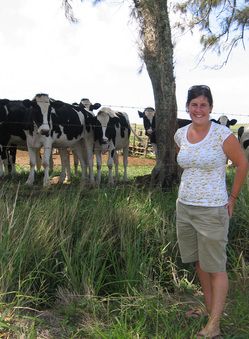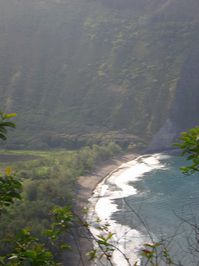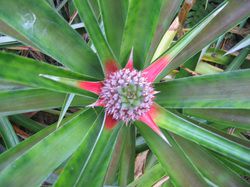In recent weeks, I’ve been kicking around an idea based on conversations with a few colleagues, who — it turns out — ended up at Minnesota Public Radio by a circuitous route. Each of them had a “previous life” of some sort that may — or may not — have served as the foundation of the life they have now.
People’s journeys to the “now” often aren’t what you think they are. Take my friend, Sara Johnson, who coordinates MPR’s “Leadership Circle,” which has very little to do with farming. Or Hawaii. Or coffee. Or feral dogs.
I told her the story would make a great NewsCut post, and she agreed to write it. That fact alone tells me that even if she hadn’t been a coffee farmer, Sara would still be unique.
 There are things I remember and things I don’t.
There are things I remember and things I don’t.
I remember it felt utterly important that I drink my first cup of coffee – ever – before I go to the Hawaiian coffee farm I’d be calling home and work for the next few months. So, reveling in how cliché I was being, I did: in Seattle, at the world’s first Starbucks.
It was rather underwhelming, but prepared me, when my plane touched down three days later on the runway that looked more like recently cooled lava than a runway (and probably was just that), for the weeks to come.
I was going to Hawaii to continue my life as a farmer, or at the very least, my life as a farmer-wannabe. After six months on an organic vegetable farm in the heartland of the United States, I found myself yearning for more farming experience. I’d landed on that farm somewhat by chance: I was worn out from the intellectual pursuits of four years of college and ready for a new experience that I’d always fantasized about, so months before graduation I spent a fall day volunteering at a farm. After just a few hours I asked the farmers if they’d have me for the whole summer, and they said, “yes.” Why I’d fantasized about this life for so long was one mystery I’d yet to unravel. While in Wisconsin, I had discovered in myself a strength, stubbornness, and work ethic that was beyond what writing a paper or doing intensive research during my college years had pulled out of me. I wanted more of that person. I wanted to keep farming. I went where it wasn’t winter and I could afford to go: Kona, Hawaii.
The transformation into my island self was a swift one. I became tan-skinned and freckled (more than usual); I became a barefoot bikini-wearing, hitch-hiking in my multi-colored halter dress woman, not-quite-free-loving-as-the-others but open nonetheless; I became machete-wielding coffee farmer, on the farm at the end of the long, bumpy road that only feet or 4-wheel drive could climb; I became aware of my tiny place in things as I looked from my perch atop that mountain, machete in hand of course, and saw ocean all around me, far as the eye could see; I became obsessed with maps that showed my distance from everything and everyone I loved; I became island dweller; and, the greatest surprise of all at the time, I became early morning riser, coffee drinker, made from the very beans we were tending.
The time I was a coffee farmer in Hawaii. I see it now from a distance, perhaps the way one might watch very old family movies of the time long before they were born. Images on the screen disjointed, a little shaky, familiar and unfamiliar at the same time. My time farming coffee in Hawaii is more about the feeling of the place and the strange stories of everyday life, moreso than the actual experience of growing, tending to, and roasting coffee. Farming was the least of it, though I marveled, like the Midwesterner I was, at avocado trees, banana plants, and funky tomato-like fruits that grew on bushes and tasted somewhat like smoked pork. They made the strangest tasting guacamole! Not to mention the deep, earthy, purple spinach that seemed to burst in your mouth and needed nothing, nothing at all to make it divine. I learned – and ate – by the system of permaculture. Things wanted to grow here, unlike my last farm in Wisconsin where it was true work to “work the land”; where I learned firsthand why people called farming “back-breaking labor.” Things in Hawaii wanted to grow. And once they grew, they wanted you to devour them, with love of course.
 A juicy tangelo dripping down my dirty face at the end of an afternoon pruning the coffee trees. Or a morning ruined by an over-eager attack of the sugarcane field, stickiness all over my hands, my teeth sore with the sweetness, and my stomach quickly cramping as a sugar-crash set in. Who knew eating could lead to such deep pleasure, and such satisfying naps? Here I could eat an avocado a day picked off the tree outside my hut and buy strange fruit from a roadside vendor, fruit that had a jelly-like center and tasted like, of all things, vanilla pudding.
A juicy tangelo dripping down my dirty face at the end of an afternoon pruning the coffee trees. Or a morning ruined by an over-eager attack of the sugarcane field, stickiness all over my hands, my teeth sore with the sweetness, and my stomach quickly cramping as a sugar-crash set in. Who knew eating could lead to such deep pleasure, and such satisfying naps? Here I could eat an avocado a day picked off the tree outside my hut and buy strange fruit from a roadside vendor, fruit that had a jelly-like center and tasted like, of all things, vanilla pudding.
Working on a coffee farm in Hawaii was about the senses being alive. And it was about leaving what you knew of life and yourself on the “mainland,” throwing it all away, and finding out who you were here.
Here I swam over a mile from shore to join a group of dolphins. Here I stuck out my thumb on the side of the road to go places. Here I put my hand in the earth to bring huge ginger roots to the surface. Here my only friends were a girl from back home who we called Goob, and two wandering souls named Scooby and Kev.
They took us to see the sunset in the “best location” on the Big Island, which ended up being at the end of a hike along rocky coastline from atop a rock practically falling into the sea, and was certainly worth it. They showed us gigantic, alien-like stingrays, attracted to the lights of a fancy hotel. They gave us a break from hitching and drove us where we needed to go, blasting Queen’s Greatest Hits the whole way. They watched as giant waves almost took me under, and laughed as I came gasping up to their beach blanket, spitting out saltwater and shaking my mop of hair, getting sand everywhere. They wanted us to know the Island they knew, and when our interest wavered for a second, they disappeared forever.
 Here I was often alone. My first hitch without Goob tested me, and I walked for many minutes before finding the courage to stick out my thumb. I was rewarded with a pickup truck of stoned and happy surfers, driven by Darren. They wanted me to come to the beach with them, but all I wanted was a ride to the market and proof that I could do this by myself. The first hitch solo made future ones easier, and helped me find the courage to also say no to rides that for whatever reason felt unsafe. Here being alone meant trusting yourself and your instincts always, and it was one of the greatest lessons the Island taught me.
Here I was often alone. My first hitch without Goob tested me, and I walked for many minutes before finding the courage to stick out my thumb. I was rewarded with a pickup truck of stoned and happy surfers, driven by Darren. They wanted me to come to the beach with them, but all I wanted was a ride to the market and proof that I could do this by myself. The first hitch solo made future ones easier, and helped me find the courage to also say no to rides that for whatever reason felt unsafe. Here being alone meant trusting yourself and your instincts always, and it was one of the greatest lessons the Island taught me.
Alone, I found myself returning home one day, and I could see the yellow house up ahead, around just a few bends that told me I was close. Suddenly, about a hundred yards ahead, a feral dog was standing, legs stiff, teeth bared, and a low growl emanating from somewhere ominous. I turned, walking away slowly, even though I didn’t know what to do. Out of sight of the wild dog – of which this place had so many and which always filled me with fear – I stopped in my tracks and gathered myself. I had nowhere to go but to that yellow house. So I turned, ready to face the dog. Around the bend where it had stood mere minutes before, was empty road. I looked around at the lush plants and jungle, and there was no movement. Not even the sense of it was left. I walked on wondering whether the dog was real or an apparition. And if the latter, what was its message to me?
This was the rhythm of the island, and my life there. Were the things you saw and experienced real, or a dream? I awoke most mornings unsure.
On the island I expected to meet people with whom I deeply connected. But the only person I discovered there was me – me without my mainland buffers or definitions or stress. It was that me who would also discover how frightening and disappointing people can be.
I quickly learned that the organic coffee farmers may have lived a seemingly idyllic existence, but just beneath the surface something more sinister stirred. Not even a week into my adventure, I began to learn of the story that influenced every other story coming out of this family of four – a tale of a single moment in time, an accident and injury that would change one, and by doing so, change them all.
They lived on the edge of chaos, and so while they could explain the principles of permaculture and complimentary farming – things growing in harmony, life dependent on each other and supporting each other – they couldn’t master the principle for their own family. The possibility of violence was always there. It was a loose thread always on the edge of unraveling the whole garment entirely. Occasionally there was a little pull, which would shake the ecosystem of the family, before sending them into silence, then something between acceptance and denial.
I found the work to be easy and a bit boring, but I learned quickly this was also a part of the island lifestyle. While the work seemed easy, being around the dysfunction of the family was not.
I stood in the grove of the coffee trees, or among the beans drying on platforms, and listened as toxic words came screaming out of the yellow house. I felt how it affected me, but I could escape it – I could go swim in the great blue ocean or walk in the shaded bamboo forest – but what about their two, young but ever-more-aware kids? Or the land itself?
As the family shook and crumbled in front of us, the coffee began to taste bitter in my mouth. It felt as infected as this place and these people. My work on the farm made me accountable somehow, and so on a day when the violence reached a new level, Goob and I decided to leave that place. We escaped on the back of Scooby’s motorcycle and a pick-up truck respectively, and didn’t look book. You didn’t look back on the island: only forward, at the horizon, at the stories yet to be told.
 Today, I don’t know how much of Hawaii is still with me, but back then my three months trained by skilled organic coffee farmers made me valuable. Goob and I pruned a coffee plantation in the next town over, in exchange for lodging on an out of season hoshidana, a coffee drying platform. I was covered by a slanted, tin roof, but otherwise open to the elements and the creatures that crept around in the darkest night I’d ever known. But the toilet and shower were downright luxurious compared to the off-the-grid farm I’d come from. So I spent my last month pruning a coffee orchard a few hours a day, exploring the rest of the Big Island during every other waking moment, finally getting my dirty body clean at the end of each adventure, and sleeping exposed to everything.
Today, I don’t know how much of Hawaii is still with me, but back then my three months trained by skilled organic coffee farmers made me valuable. Goob and I pruned a coffee plantation in the next town over, in exchange for lodging on an out of season hoshidana, a coffee drying platform. I was covered by a slanted, tin roof, but otherwise open to the elements and the creatures that crept around in the darkest night I’d ever known. But the toilet and shower were downright luxurious compared to the off-the-grid farm I’d come from. So I spent my last month pruning a coffee orchard a few hours a day, exploring the rest of the Big Island during every other waking moment, finally getting my dirty body clean at the end of each adventure, and sleeping exposed to everything.
Was I a coffee-farmer? Or a drifter sleeping in the open air? Or a seeker and traveler trying to figure out who I was outside of my normal context?
You asked me to tell you about the time I was a coffee farmer in Hawaii. Is that this story? All I know is this is the story of when I was not who I am now. It’s the story of when I was someone else.
(All photos courtesy of Sara Johnson)
